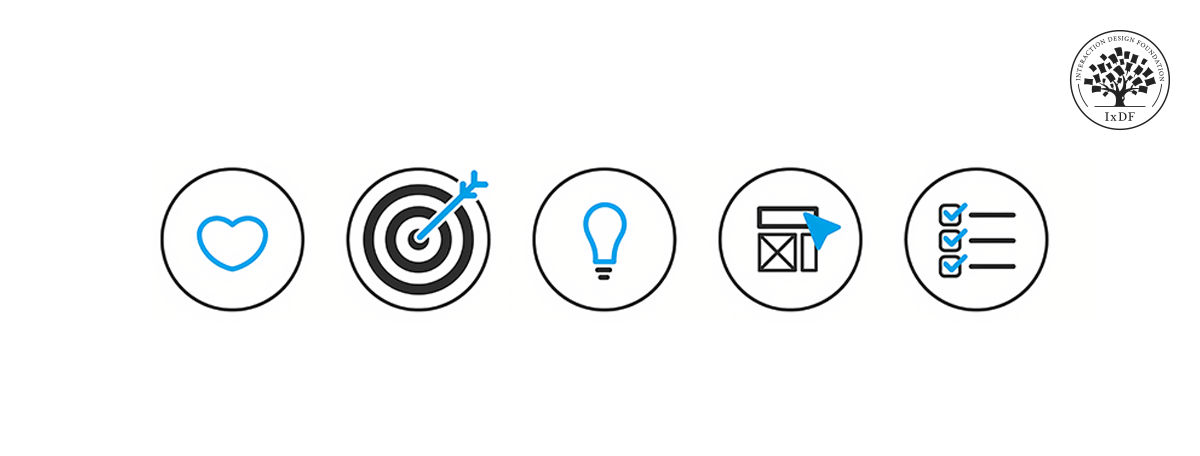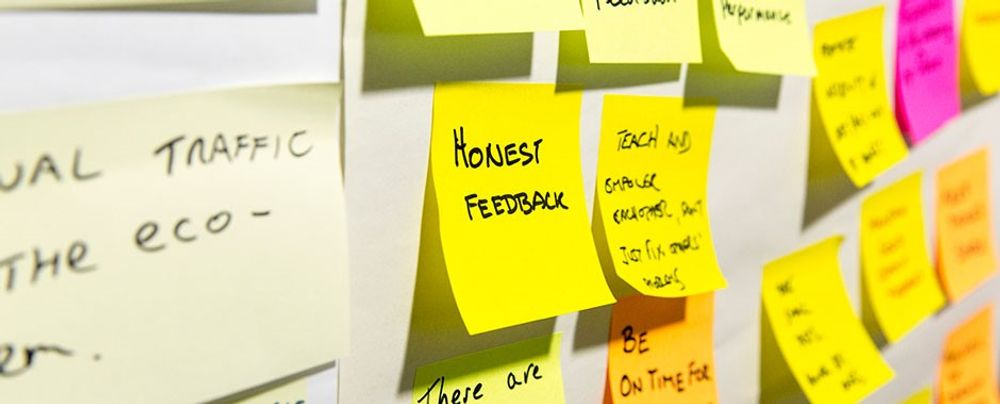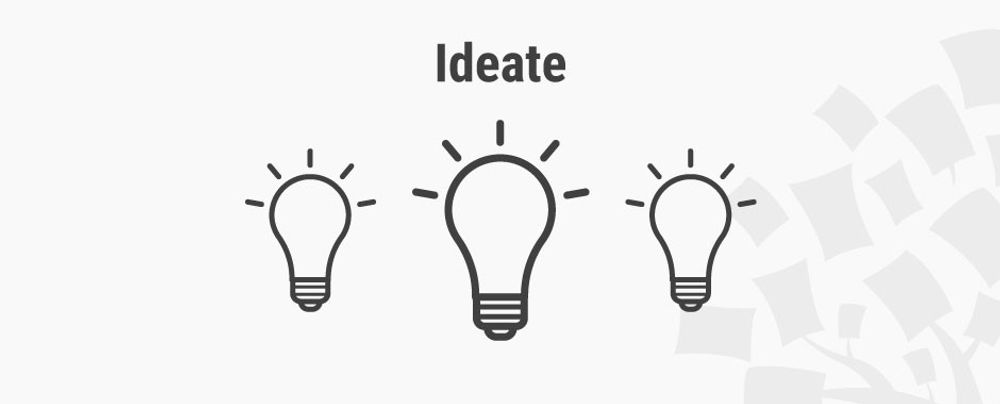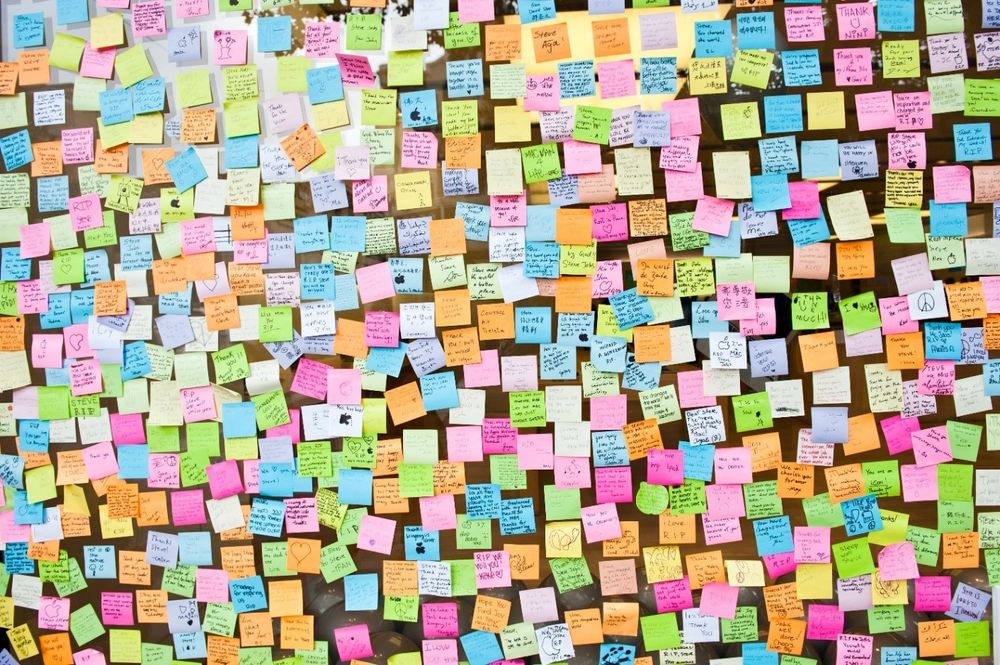Do you have the ambition and enthusiasm for a career in UX design but don’t know where to start? You’ll be pleased to know there are many paths you can take. Even as a relatively new field, user experience (UX) design has both general and specialist job roles. This variety means there is a role waiting for you that fits you perfectly based on your passions and experience. However, UX roles can sometimes be confusing—you may find the same position at different companies but with different names. Here, we’ll look at eight common UX roles and how they contribute to the design process. Soon, you’ll clearly understand which job role is the right fit for you.
A common misconception is that UX is just what you see in the final product. However, the tangible elements of a product are just the tip of the UX iceberg, as explained in this video:
UX design is still a relatively new industry. The first job to include the term “user experience” was Don Norman’s role as User Experience Architect at Apple in 1993. New UX roles and specializations are appearing constantly, and the field continues to evolve as technology and user needs change. For this reason, user experience is an incredibly exciting industry to be a part of—a fact that has likely brought you here.
Unravel UX Roles and Find Your Perfect Fit
Kate Conrick, a designer working for the Australian government, aptly sums up the sometimes-confusing state of UX roles:
“I built on my background in tech and design, picked up some solid research skills, added some business process and a sprinkle of marketing, and voila! A user experience designer. Or a Service Designer? A UX Researcher? A digital strategist? An experience analyst? Design thinker? Stuff tinkerer? Unicorn? Power ranger? You tell me. Because I’m not sure I know the answer.”
—Kate Conrick
If you’re confused about UX roles, you’re not alone. But don’t worry; you’ll soon have a strong grasp of the different UX roles available and which one you’d like to pursue. With your destination in hand (i.e., the role you aspire to), you can plot your course to becoming a UX extraordinaire. Eight of the most common UX roles are:
UX Designer.
UI Designer.
Product Designer.
UX Researcher.
UX Engineer.
UX Writer.
Service Designer.
UX Unicorn (yes, this is a real job title!)
Once you’ve chosen your role, one of the primary stepping stones on your journey is to build your UX/UI design portfolio—an essential asset for your UX career. In this video, Morgane Peng, Design Director at Societe Generale CIB, explains what a portfolio is and its purpose:
For each UX role, you’ll learn the expected tasks and deliverables and get a rough idea of whether you’ll like the role. Ready to make sense of UX roles?
Forget The Semantics and Focus on the Design Process
With all these job titles, it’s essential to contextualize their collective purpose—all UX roles exist to serve the design process. A great way to understand UX roles is to examine how they contribute to the design process. UX professionals perform a whole slew of UX tasks as they go through a design process to create a final design.
For instance, designers usually start by understanding users before they create designs and test them. Different UX roles simply take charge of various subsets of these UX tasks.

Design thinking is one of the most common design methodologies and helps illustrate where each UX role fits. As you can see, the stages are closely connected; they overlap and are iterative by nature. This overlap is partly why job roles are often so difficult to define and separate completely.
© Interaction Design Foundation, CC BY-SA 4.0
The design thinking process involves 5 phases that feed into one another:
Empathize: Where you learn about your users.
Define: Where you identify problems and user needs.
Ideate: Where you generate design ideas to solve the problems.
Prototype: Where you create mockups and, eventually, the final product.
Test: Where you test your designs with users to improve them.
These are some of the key UX tasks designers perform in each of the phases:
| Example task 1 | Example task 2 | Example task 3 |
Empathize | User interviews | Contextual inquiry | Survey |
Define | Persona creation | Journey mapping | Affinity diagramming |
Ideate | Brainstorming | Worst possible idea | Storyboarding |
Prototype | Paper prototyping | Wireframing | Hi-fi prototyping |
Test | Usability testing | Heuristic evaluation |
Each UX role explained below performs a slightly different range of these key UX tasks. For instance, a UX Designer is a generalist who takes charge of all the UX tasks, while a UX Researcher focuses on the empathize and test phases.
If you frame each role within the design process, it will help you see the big picture. That way, when a new job title pops up, you’ll be able to understand it in the context of the design process.
On top of that, companies might define UX roles differently. However, once you understand UX roles as “how they contribute to the design process,” you’ll be less confused when you go job hunting and portfolio building. In other words, you’ll focus less on the job title and more on what you’ll be doing.
The design process will also aid in your portfolio, as you’ll be able to target specific roles based on the stages you include in your UX case studies. For example, if you want to become a UX Researcher, you will want to focus on the empathize, define, and test stages in your case studies.
Enough talk; let’s look at the eight most common UX roles!
UX Designer: The All-Rounder
The role of a UX Designer is an exciting one! UX Designers cover the entire design process. This means you’ll get the satisfaction of seeing products or features go from a user problem to a final solution. As a UX Designer, you’ll:
Deeply understand your users, their needs, and what they want to achieve.
Generate and ideate ideas to solve your users’ problems.
Prototype designs and test them with users.
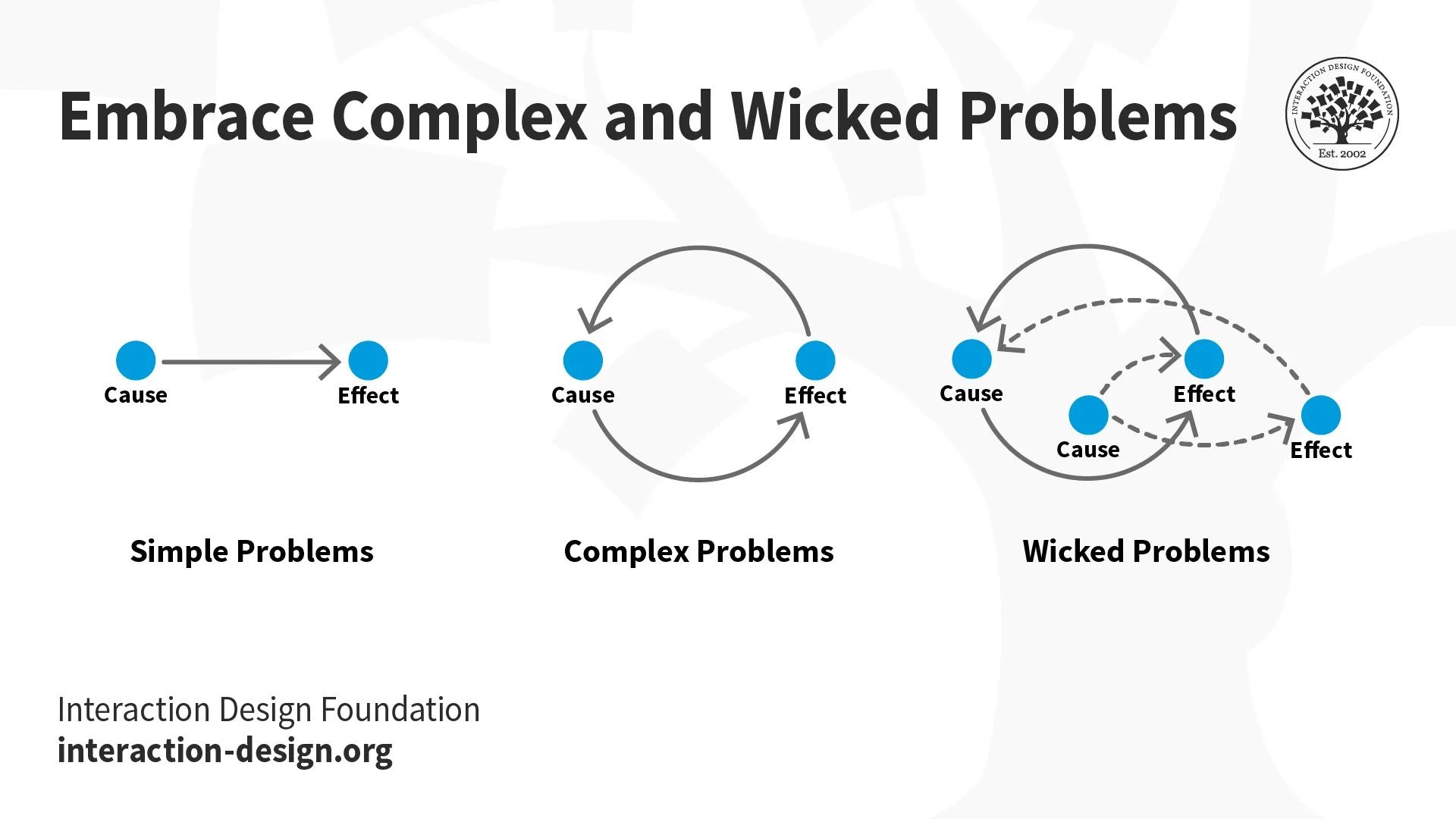
Do you have excellent problem-solving abilities? Then you’re in the right place! UX design is all about problem solving, from simple problems that have a single cause and effect to wicked problems that require a little more thought and ingenuity to solve.
© Interaction Design Foundation, CC BY-SA 4.0
The role of a UX Designer can look different depending on the size of the company. In large companies, a UX Designer typically works in a dynamic team with other UX professionals, including UX Researchers and UI Designers. In smaller companies like start-ups, UX Designers tend to handle all the design work. This means there’s a UX Designer role out there for you, whether you love to collaborate with specialists or own the whole design process.
UX Designers Are Also Known as...
UI/UX or UX/UI Designers (a User Interface (UI) Designer with some UX skills or vice-versa).
Experience Designers.
What Tasks Will You Perform as a UX Designer?
A UX Designer conducts all kinds of UX activities as part of their role. As a UX Designer, you will:
Conduct user research through interviews, observations, and other research methods.
Based on your user research, analyze and identify pain points from the users’ perspective.
Generate ideas through ideation techniques, such as brainstorming and worst possible idea. These techniques help to solve the users’ needs in a way that provides value to the company.
Select the most promising idea(s) based on their feasibility, desirability, and viability.
Prototype designs, which can range from simple paper sketches to high-fidelity digital mockups.
Provide and solicit feedback on your designs as well as the designs of your teammates.
Conduct usability and user tests to determine if you can improve your design(s) further.
Push a design solution out into the world that will benefit both your company and your users.
What UX Deliverables Will You Produce as a UX Designer?
While each company—and indeed, each team within a company—expects different deliverables from a UX Designer, the most common ones are:
User research reports.
User journey maps.
“How might we” statements that capture a problem that your design aims to solve.
Paper prototypes.
Wireframes.
High-fidelity, pixel-perfect mockups.
Usability reports.
Heuristic evaluation reports.
User testing reports.
Design pattern libraries, style guides or design systems.
You’ll Love Being a UX Designer if you...
Want to be involved in the entire design process, from the initial stage of understanding users to the final stage of producing a high-fidelity prototype.
Love to learn and master a wide range of topics and skills, including:
Information Architecture.
Psychology.
Interaction design.
Are fulfilled by analyzing complex data to produce design goals that you then work towards.
Thrive on creating intuitive and useful solutions that solve the problems users face in their lives.
UI Designer: Where Aesthetics and Usability Meet
UI Designers combine usability with visual design to build intuitive user interfaces. This role is an excellent fit if you’re a creative person who wants to incorporate psychology, user behavior analysis, and visual storytelling into your work.
Since a UI is a significant component of a product, it requires research, ideation, prototyping, and testing. Therefore, as a UI Designer, you have the chance to get involved in all five stages of the design thinking process.
Many UX Designers also take on UI design responsibilities, but it's important to remember that UI design is a component of UX design—they are not synonymous. Discover more about UI vs UX in this video:
UI Designers Are Also Known as...
Interface Designer.
UX/UI or UI/UX Designer.
What Tasks Will You Perform as a UI Designer?
As a UI Designer, you will:
Use your visual design skills to create attractive interfaces that align with brand guidelines and meet user needs. Color, typography, graphics, and Gestalt principles all play a role in UI design.
Design layouts with well-organized, consistent, and accessible content across all devices.
Develop and maintain product design systems. Design systems include components like buttons, icons, and typography styles.
Apply accessibility standards and cultural considerations to produce inclusive designs.
Collaborate with UX Designers to turn wireframes and prototypes into refined, high-fidelity designs.
Provide detailed design specifications and assets to front-end developers.
What UX Deliverables Will You Produce as a UI Designer?
As with UX design, UI design deliverables vary from company to company. However, the most common deliverables include:
High-fidelity UI designs.
Interactive prototypes that showcase animations and transitions.
Design systems, including components like buttons, icons, and other reusable elements.
Visual style guides that include typography, color palettes, spacing rules, and more.
Responsive design layouts for various screen sizes and devices (such as mobile and tablet devices).
Documentation and design files for developers.
You’ll Love Being a UI Designer if you...
Relish the challenge of perfecting the balance between aesthetics and usability.
Are passionate about visual design and its principles, such as typography, color theory, and layout.
Thrive in the structure that comes from design systems and clear rules for branding, but know when to break the rules.
Are ready for the challenge of making complex information easy to navigate through thoughtful design.
Aspire to collaborate with UX Designers and developers to bring high-fidelity designs to life.
Have excellent attention to detail and get obsessed with the minutia of a design.
Product Designer: Upgrade to Business Class
Are you excited about becoming a UX Designer, but wish you could incorporate your business acumen into the role? Well, you’re in luck! Product Designers pay special attention to the product as a whole on top of the user’s experience.
As a Product Designer, you will contribute to the creation and management of the product’s designs, goals, and roadmap. A product roadmap is a high-level strategic summary of the direction of the product’s offerings and features.
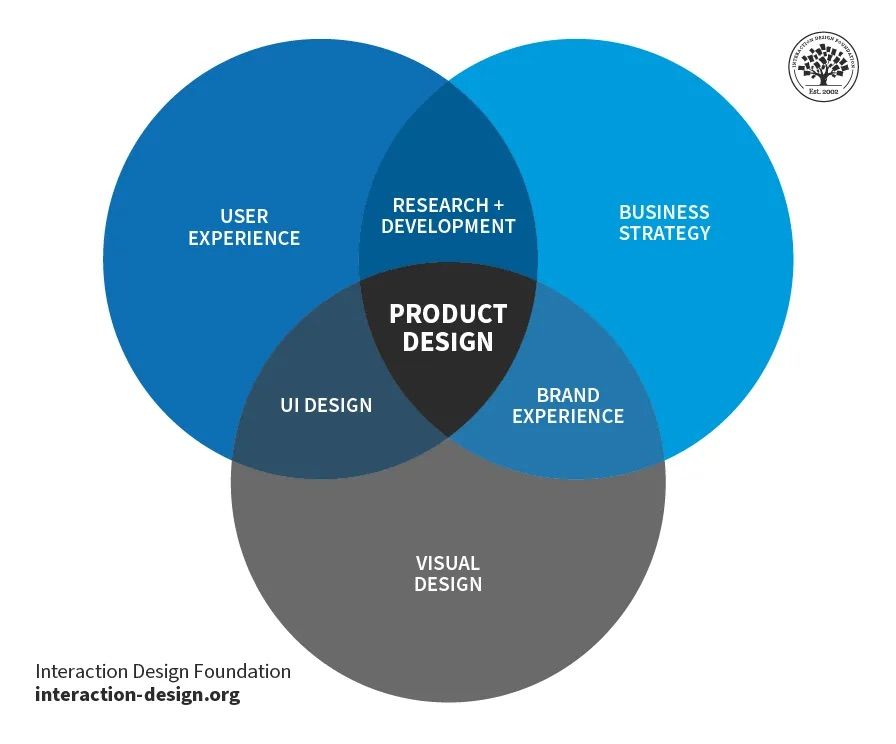
Product design lies at the intersection of UX, visual design, and business strategy. While all UX designers consider business goals when designing user experiences, product designers must consider not only today’s business goals but also those of the long term.
© Interaction Design Foundation, CC BY-SA 4.0
Product Designers Are Also Known as...
There aren’t any synonyms for Product Designers. Some companies define Product Designers as identical to UX Designers. Other companies view Product Designers as senior UX Designers who have the added responsibility of charting a product’s goals and roadmap.
What Tasks Will You Perform as a Product Designer?
All the tasks listed under “UX Designer” above, plus:
Inform and plan the product’s roadmap 6–12 months into the future.
Collaborate closely with development to ensure they can successfully implement designs.
Work with marketing teams to communicate and plan product launches.
What UX Deliverables Will You Produce as a Product Designer?
Product Designers produce all the deliverables listed under “UX Designer” above, in addition to product roadmaps. You will likely co-develop roadmaps with stakeholders such as team leaders, the product manager and the CEO.
You’ll Love Being a Product Designer If You…
Are passionate about design and business.
Are excited by developing and integrating business goals into design and product decisions.
Want to participate in the entire design process.
Are ready to develop a deep knowledge of design and a good understanding of business.
Have a knack for analyzing data and reaching conclusions that balance business goals with user needs.
UX Researcher: The User’s Champion
UX Researchers bring the voice of the user into every part of the design process. They spend their days talking with users, analyzing data, and using their findings to influence design decisions. As a UX Researcher, you’ll participate in the empathize, define, and testing phases:
You’ll empathize with users to really get to know them and their needs.
You’ll define the problems that the product should solve.
Once the design team has created a prototype, you will test it with users and help validate and improve designs.
Discover more about UX research in this video:
UX Researchers Are Also Known as...
User Researchers.
Researchers.
What Tasks Will You Perform as a UX Researcher?
As a UX Researcher, you will:
Gain a rich and complete understanding of users through qualitative user research methods. Methods include user interviews, user observations, and field studies.
Conduct quantitative user research using methods like surveys and card sorting. This research will confirm your qualitative research outcomes and inform design decisions.
Analyze the data you’ve gathered on users to synthesize key findings and make design proposals.
Advocate for users’ needs and perspectives within the design team.
Help inform product goals by presenting your research findings to stakeholders.
Test and improve designs by conducting evaluative research, such as usability and user testing.
What UX Deliverables Will You Produce as a UX Researcher?
These are the main deliverables you’ll create as a UX Researcher:
User research reports (for various qualitative and quantitative research methods).
User personas.
User stories.
User journey maps.
“How might we” statements.
Usability/user testing reports.
Heuristic evaluation reports.
You’ll Love Being a UX Researcher If You…
Have a strong passion for human psychology and the study of people.
Enjoy stepping into users' shoes to empathize with them and build a rich and deep picture of their perspectives and problems.
Are well-versed in psychology or interested in learning deeply about it.
Get excited about generating and analyzing complex data.
UX Engineer: A Bridge Between Design and Development
UX Engineers exist in the gap between design and development teams. If you’re a developer who understands and advocates for user experience, then you might have just found your perfect role. You can find UX Engineer positions at large companies with strong UX maturity. Given their coding and UX abilities, a typical responsibility of UX Engineers is to build high-fidelity prototypes that closely resemble the final product.
In this video, Syzmon Adamiak, Co-Founder of Hype4, explains the importance of good communication when designers hand off designs to developers:
UX Engineers Are Also Known as...
Creative Technologists.
Product Design Engineers.
Design Technologists.
What Tasks Will You Perform as a UX Engineer?
Build high-fidelity, functioning prototypes using your UX and coding skills.
Package designs and communicate them in a developer-friendly format.
Work across research, design, development, and product management teams.
Front-end development tasks such as implementing UIs and new features.
What UX Deliverables Will You Produce as a UX Engineer?
Many of the same deliverables as a UX Designer, plus:
Polished and final prototypes.
Component libraries.
Code documentation.
You’ll Love Being a UX Engineer if you...
Perform best with a varied and multidisciplinary workload.
Have the desire to utilize both coding and UX skills.
Enjoy a fast-paced work environment where you will build rapid but functioning prototypes.
UX Writer: The Master Communicator
If you’re passionate about words and user-centered design, then you will make an excellent UX Writer. Copy is one of the most essential parts of a design, and it requires a specialist touch to optimize it for the best results.
As a UX Writer, you’ll write instructional text, onboarding content, and microcopy for buttons, error messages, and tooltips. You’ll contribute to the prototype phase of the design process, and you are crucial in finalizing the product before launch.
Torrey Podmajersky, UX Writer, explains how to get into UX writing:
UX Writers Are Also Known as...
Copywriters.
Content Strategists.
Content Designers.
What Tasks Will You Perform as a UX Writer?
As a UX Writer, you will:
Write copy for user interfaces so people can easily navigate, use, and troubleshoot the product.
Create compelling page titles and navigation menu item names for optimal usability.
Write error messages that are simple, effective, and blame-free. In the unfortunate event of an error, users should feel assured rather than annoyed.
Craft effective emails and newsletters to achieve product goals (such as account signups).
Weave a cohesive narrative throughout the product. Users should experience a consistent tone of voice and direction no matter which screen or page they access.
Define and maintain a vision for the product’s language that other stakeholders will use.
Test your copy for performance and improvements.
What UX Deliverables Will You Produce as a UX Writer?
As a UX Writer, most of your work will be directly incorporated into the product itself, so it often won’t appear as a standalone deliverable. As a result, your most common deliverables are:
Copy, which you will incorporate into the product itself.
Editorial guidelines or product language guidelines that set the tone and content style for the product.
You’ll Love Being a UX Writer if you...
Have a strong desire to help users achieve their goals with the least cognitive load.
Can strongly empathize with your users and understand their goals.
Are passionate about achieving product and business goals.
Possess deep knowledge in writing and a solid understanding of UX design.
Enjoy using empathy, data, business goals, and logic to inform your writing.
Service Designer: People, Processes, and Places
Service Designers create cohesive, end-to-end solutions for services. This role is for you if you’re passionate about UX but want to take a wider view and design a service holistically. Service Designers focus on every touchpoint a customer or user interacts with and the internal processes that support the service. For example, a UX Designer may focus on the design of an ordering screen at a fast-food restaurant. However, a Service Designer will consider the entire customer journey, from how they find the restaurant to when they pick up their order.
Service Designers are involved in every stage of the design process, from research to testing. They cover multiple disciplines, including UX, customer experience (CX), and operations. In this video, Frank Spillers, CEO of Experience Dynamics, explains what service design is and isn’t:
Service Designers Are Also Known as...
Experience Designers.
Customer Experience Designers.
What Tasks Will You Perform as a Service Designer?
Service Designers have a broad remit and carry out many tasks. They:
Map the entire service journey, including both customer-facing and behind-the-scenes processes.
Visit competitors, analyze their services, and discover what works and what doesn’t.
Conduct research with customers and employees to understand pain points and moments of delight.
Design service blueprints to outline how all parts of the service interact.
Collaborate with UX Designers, CX professionals, and operations teams to optimize service delivery.
Prototype and test solutions with customers and employees.
Align digital and physical service touchpoints for a consistent and immersive experience.
What UX Deliverables Will You Produce as a Service Designer?
Many of the same deliverables as a UX Designer, plus:
Service blueprints.
Business model canvases.
Value proposition canvases.
Ecosystem maps.
Experience prototypes.
Employee experience maps.
You’ll Love Being a Service Designer if you...
Enjoy solving complex, system-wide challenges that cover multiple touchpoints and interactions.
Thrive on designing holistic, end-to-end experiences that benefit customers and service providers.
Are passionate about improving not only the user experience but the operational efficiency of services.
Love working at the intersection of UX, CX, and business strategy.
Enjoy collaborating with various stakeholders, from customers to frontline employees and business leaders.
Have a keen interest in research with both customers and employees to gain actionable insights.
UX Unicorn: The Mythical Start-up Beast
You will typically find UX Unicorns in the world of tech start-ups. If you’re someone who possesses the usual set of skills required for a role and additional skills in another domain, then you might just be one of them. These additional skills multiply the value a unicorn contributes to a business—hence the legendary name.
A UX Unicorn is similar to a UX Engineer and typically refers to a UX Designer proficient in design and front-end or even full-stack development. Where UX Engineers and unicorns differ, however, is that the engineer is part of a team, whereas the unicorn often is the team. However, UX Unicorns that can achieve results comparable to those of a designer and developer team are extremely rare.
What Tasks Will You Perform as a UX Unicorn?
All the tasks listed under “UX Designer” above, plus:
Develop live front-end prototypes to test with users for more realistic results than a static prototype.
Implement the front-end code of a design. In exceptional circumstances, the unicorn may also implement the back-end code.
What UX Deliverables Will You Produce as a UX Unicorn?
All the deliverables listed under “UX Designer” above, plus:
Front-end prototypes.
Front-end code that is ready for launch.
You’ll Love Being a UX Unicorn if you...
Excel at both UX design and development, and have a desire to take on both roles. A UX Unicorn is the sort of phenomenon that happens if, for instance, you have been an active hobbyist for years. If you’ve got a strong passion for and deep knowledge of front-end development, this might just be the role for you.
Take Your Pick: Which UX Role Should You Go For?
Which of these eight UX roles speaks to you the most? If you cannot decide, Stephen Gay’s advice might help you. Stephen Gay is the UX Lead of Google One, and he recommends that you choose your design role based on your passion and skills:
Video copyright info
© The Interaction Design Foundation, CC BY-SA-NC 3.0.
If you’re still unsure, know that many people start their UX journey with the UX Designer role. This allows you to experience the different specializations, and if you find you especially like one of them, you can dive deeper into it.
UX Roles Are Ever-Changing
UX roles are in flux—and likely always will be. After all, designers seem to have a limitless amount of creativity that makes them reinvent and redefine roles every few years. For example, artificial intelligence and voice interaction are two areas where the demand for new UX practices is rapidly growing.
When you go job-hunting, remember that different companies might define roles differently. Large companies, for instance, tend to hire specialist designers, so they often have specific roles such as “User Researcher” and “UI Designer.” Small and medium-sized companies, on the other hand, tend to prefer generalists and will have roles such as “UX Designer” or even “UI/UX Designer.” Always carefully read the job description of an opening before you apply, and check the requirements to see where they fit within the design process.
Next Steps: Build a Standout Portfolio
Once you’ve chosen your role, your next course of action is to build your UX portfolio. And you can get started right away! You can use student projects, hobby projects, hypothetical projects, and more to create case studies that will get you hired.
Remember that each case study is a story, and you’re in complete control of how it is told. For example, if you start as a UX Designer and realize you are most engaged with UI design, you can translate any project into a focused UI design case study.
You can even reframe your past non-design experiences into the UX role you’re aiming for, as Morgane Peng explains in this video:
The Take Away
UX roles can be confusing and overlap in some ways, but all exist to serve different parts of the design process. A great way to understand UX roles is to identify which phases of the design process they contribute towards.
“The only way to be truly satisfied is to do what you believe is great work, and the only way to do great work is to love what you do. If you haven't found it yet, keep looking, and don't settle. As with all matters of the heart, you'll know when you find it.”
—Steve Jobs
Here’s a quick summary of the eight common UX roles:
UX Designers take charge of the whole design process and work on all five phases of the design thinking process.
UI Designers focus specifically on a product’s UI and combine visual design with usability.
Product Designers are like UX Designers but also help chart a vision of the product’s mid-to-long-term roadmap.
UX Researchers focus on understanding and advocating for users. They participate in the empathize, define, and test phases.
UX Engineers fill the gap between designers and developers and use both UX and developer skills.
UX Writers are all about crafting persuasive, clear, consistent copy that contributes to the prototype phase.
Service Designers take a holistic approach when they design services and cover the disciplines of UX, CX, and operations.
UX Unicorns are rare people who handle both UX design and front-end development, typically by themselves.
Aim for a role that matches your passion and skills. If you’re still working out what excites you about UX, get started as a UX Designer to allow you to experience different areas of the field. You can then narrow your focus as you discover what you truly enjoy doing.
Finally, once you’ve chosen a role, you can get started on your portfolio, and you’ll be preparing for interviews in no time!
References and Where to Learn More
Take our course with Morgane Peng to Build a Standout UX/UI Portfolio and Land Your Dream Job.
If you don’t have any UX experience, discover 3 Ways to Find Projects for Your UX/UI Design Portfolio Case Studies.
Find out How to Use Visuals to Elevate Your UX/UI Design Portfolio Case Studies, regardless of the role you choose.
Learn more about the following disciplines in our topic definitions:
For a robust foundation in UX, take our courses, Design Thinking: The Ultimate Guide and User Experience: The Beginner’s Guide.
Discover How Much You Can Earn as a UI & UX Designer.
Read Kate Conrick’s thought-provoking article on UX roles, We Need to Talk About UX Roles.
Find out why Jakob Nielsen’s believes that AI may bring about more UX Unicorns.
Images
Hero image: © Interaction Design Foundation, CC BY-SA 4.0
